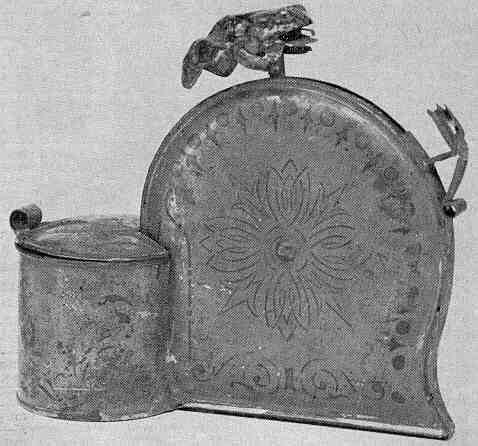Frog on Arched Track Bank
by F.H. Griffith - HOBBIES Magazine - January, 1961

An interesting early tin mechanical bank is our choice as No. 91 in the numerical classification of mechanical banks. The bank is the Frog On Arched Track. One of its points of interest has to do with the fact that a penny is necessarily involved in the action and operation of the bank. Also the 1871 date of the bank adds great interest when we realize that in only eleven more years it will be 100 years old.
It is fairly accurate to assume that the Frog On Arched Track was not made over a long period of time nor in any great quantities since all factors surrounding the bank indicate this to be so. Therefore, using the patent date of 1871 to establish the age of the bank at 100 years in 1971 is logical. For comparison this could not be done on the same basis in the case of the Tammany Bank.
The Tammany was made over a long period of years and in great quantities but all specimens of the bank bear the same early patent date of December 23, 1873. However, certain minor casting changes in the name, the base plate, coin trap, and so on can be used to identify and place individual examples of the bank in fairly accurate periods and time of manufacture. These factors surrounding the Tammany Bank are of interest, however, they do not have any great meaning from a monetary standpoint since all examples of the bank sell in the same price range provided their general condition is comparable.
The Frog On Arched Track was patented December 5, 1871 by James Fallows of Philadelphia, Pa. The patent papers frequently mention and always refer to the figure as a toad, not a frog, but the bank has been known for years as the Frog On Arched Track and this name has been descriptive enough to identify it. Under the circumstances it would seem best to continue to use the established name rather than change it to the Toad On Arched Track and possibly cause confusion.
It should be noted that Mr. Fallows’ patent papers were issued on the basis of an "Improvement In Toy Toads," not as a mechanical bank, toy money box, or savings device. However, since there is a receptacle that retains the coins and since it has been accepted over the years as a toy savings device, then it is probably properly classified as a mechanical bank. There are, however, known examples of toys that use a coin in their action that are not mechanical banks and had no provision for retaining the coins. These are simply toys and have no possibility of being classed as mechanical banks.
The bank shown is from the collection of Leon J. Perelman and he obtained it several years ago from an antique dealer in Sanatoga, Pa., who had found the bank in a home in the vicinity. It is completely original, in good working order, and the paint shows very little wear, particularly for a tin stenciled bank of this type and age. The entire bank with the exception of the green toad is painted a bright reddish orange color. There are stenciled designs in gold on the arched sides and the den of the toad. The patent date of the bank is also stenciled in gold. While the bank is made of heavy tin it bears mention that the toad is a brass stamping.
The bank operates as follows: The toad is placed in its den and the lid is closed (this is the canister-like section at the left end of the bank as pictured). A penny is inserted in the holder at the end of the arched track. The lid of the den is then raised manually and the toad jumps out of its den, travels over the arched track and grabs the coin in its mouth. The toad then recedes back on the track toward the den. Meantime the coin moves through the body of the toad and at the proper moment drops into the container. The toad is replaced by hand in the den for future action. The den, of course, serves the double purpose as a container for the coins and the toad. A point of interest is the fact that the bank works on a counter-balance principle as there is a weight within the bank which causes the toad to swing out over the track and then back over the track.
The Frog On Arched Track is a difficult bank to add to a collection, and particularly so in the condition of the one in Mr. Perelman’s possession. The action is interesting, it is an early item, and only a few are known to exist in private collections.
